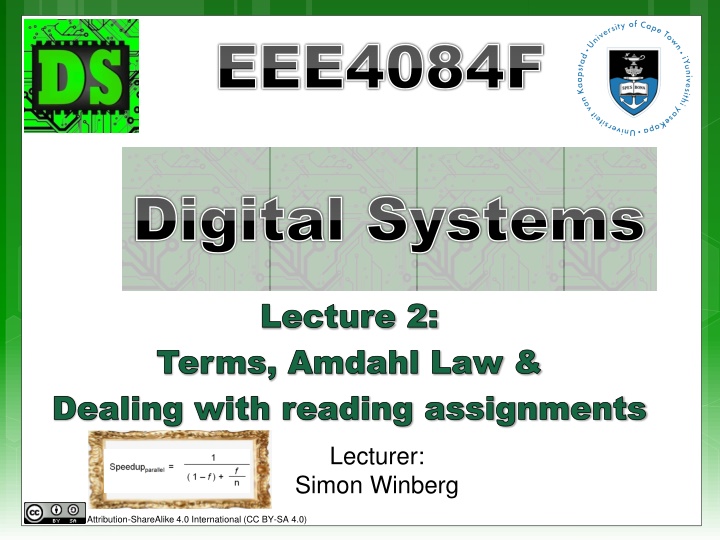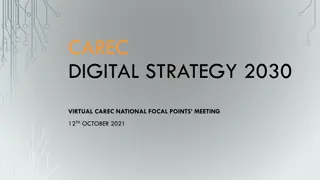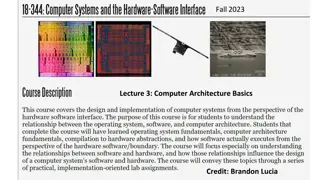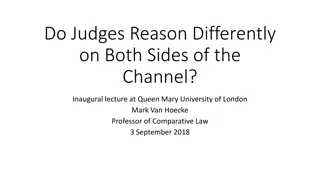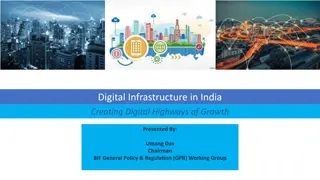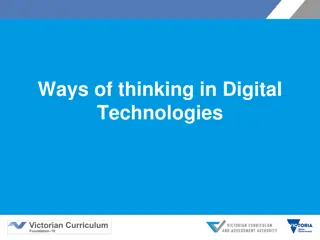Digital Systems Lecture 2: Terms & Amdahl Law Summary
This content provides a summary of a lecture on digital systems focusing on terms, validation vs. verification, commonly used verification methods, and Amdahl's Law. It also covers dealing with reading assignments and quiz activities in the class.
Download Presentation

Please find below an Image/Link to download the presentation.
The content on the website is provided AS IS for your information and personal use only. It may not be sold, licensed, or shared on other websites without obtaining consent from the author.If you encounter any issues during the download, it is possible that the publisher has removed the file from their server.
You are allowed to download the files provided on this website for personal or commercial use, subject to the condition that they are used lawfully. All files are the property of their respective owners.
The content on the website is provided AS IS for your information and personal use only. It may not be sold, licensed, or shared on other websites without obtaining consent from the author.
E N D
Presentation Transcript
EEE4084F EEE4084F Digital Systems Digital Systems Lecture 2: Terms, Amdahl Law & Dealing with reading assignments Lecturer: Simon Winberg C:\Users\swinberg\Documents\ACTIVE\EEE4084F\Common\Images_open\CC-SA.png Attribution-ShareAlike 4.0 International (CC BY-SA 4.0)
Outline for Lecture Class Activity Quiz#0 Terms Validation vs. Verification Commonly used verification methods Amdahl s Law Dealing with reading assignments
TODO short quiz EEE4084F Digital Systems
Class Activity Quiz #0 - Initial impressions 10 minutes to complete a few simple survey questions and prerequisite tests. This quiz is not for marks Name & student number voluntary
Marking of Quiz0 ?! Please swap your Quiz0 with a buddy I ll show you the correct solutions in a moment Please hand back your quizzes at end of the lecture (you re about to find out why!)
Quiz 0 marking other slideshow
TERMS TRENDS
Terms Golden measure: A (usually) sequential solution that you develop as the yard stick A solution that may run slowly, isn t optimized, but you know it gives (numerically speaking) excellent results E.g., a solution written in OCTAVE or MatLab, verify it is correct using graphs, inspecting values, checking by hand with calculator, etc. Discussed a bit more later
Terms Sequential / Serial (serial.c) A non-parallized code solution Generally, you can call your code solutions parallel.c (or para1.c, para2.c if you have multiple versions) You can also include some test data (if it isn t too big, <1Mb), e.g. gold.csv or serial.csv, and paral1.csv
Speed-up Speed-up = Tp1 /Tp2 Where Tp1 = Run-time of original (or non-optimized) program Tp2 = Run-time of optimised program Best practice for measuring speedup: Run the program more than one, discarding the first result (where the cache, etc. is getting warmed up ) To be precise should indicate results from when system wasn t warmed up * * (which can be simulated by running a whole lot of other things like CounterStrike, Half-Life, maybe some Solitare* for good measure -- but more seriously you could write your own cache cleaning program )
Other Important Terms Verification Validation Testing Correctness proof These terms are not merely theoretical terms to remember, but relate directly to your project. Not something done in the project (but if you want to, you can experiment with doing a correctness proof if you are keen)
Verification and Validation (V&V) Two terms you should already know Verification Are we building the product right? Have we made what we understood we wanted to make? Does the product satisfy its specifications? Validation Are we building the right product? Does the product satisfy the users requirements Verification before validation (except in duress) While it would be nice to be able to validate before verifying, doing so would mean your specifications and design may be wrong in the final version (obviously this sometimes happens in practice due to insufficient time for proper validation) Sommerville, I. Software Engineering. Addison-Wesley, 2000.
Verification before validation The RC engineer (i.e., you) are effectively designing both custom hardware and custom software for the RC platform Before attempting to make claims about the validity of your system, it s usually best practice to establish your own (or team s) confidence in what your system is doing, i.e. be sure that: The custom hardware working; The software implementation is doing what it was designed to do; and The custom software runs reliably on the custom hardware.
Verification Checking plans, documents, code, requirements and specifications Is everything that you need there? Algorithms/functions working properly? Done during phase interval (e.g., design => implementation) Activities: Review meetings, walkthroughs, inspections Informal demonstrations Focus of project Focus of project
Commonly used verification methods 1. Dual processing, producing two result sets One version using PC & simulation only; Other version including RC platform 2. Assume the PC version is the correct one (i.e., the gold measure) 3. Correlate the results to establish correlation coefficients (complex systems may have many different sets of possibly multidimensional data that need to be compared) The correlation coefficients can be used as a kind of confidence factor 1. 2.
Focus of project Validation Testing of the whole product / system Input: checklist of things to test or list of issues that need to have been provided/fixed Towards end of project Activities: Formal demonstrations Factory Acceptance Test
Testing and Correctness proofs Testing Generally refers to aspects of dynamic validation in which a program is executed and the results analysed Correctness proofs / formal verification More a mathematical approach Exhaustive test => specification guaranteed correct Formal verification of hardware is especially relevant to RC. Formal methods include: Model checking / state space exploration Use of linear temporal logic and computational tree logic Mathematical proof (e.g. proof by induction)
Speed-up Number of processors Amdahl s Law EEE4084F
Amdahls Law: History The guy: Gene Amdahl Was chief architect for IBM's first mainframe series of computers Founder of Amdahl Corporation Amdahl found stringent restrictions on the speedup possible for given parallelized tasks. Thee observations packaged as: Amdahl's Law
Linux Magazine Video: Understanding Parallel Computing: Amdahl's Law https://www.youtube.com/watch?v=WdRiZEwBhsM Amdahl.flv
Amdahls Law Define f as: fraction of computation that can be parallelized (ignoring scheduling overhead) Then (1 - f ) is the fraction that is sequential Define n = no. processors for parallel case The maximum speed-up achievable is: 1 Speedupparallel = f n ( 1 f ) + Should be able to remember this formula for exams
Amdahls Law: Alternate Representation P = expected performance improvement Eu = Execution time on a uniprocessor (serial) Ep = Execution time on a number of processors (parallel) n = number of processors S = fraction of time spent in the sequential time
Homework task Watch 2ndpart of Amdahl s law video Understanding Parallel Computing (Part 2): The Lawn Mower Law LinuxMagazine Amdahl2.flv
Dealing with reading assignments, seminar and blog You are suppose to read (at least speed read) the chapters and readings assigned for each seminar Each Seminar Facilitation Group meant to read their aspects in depth, i.e. Whole team to read word-for-word over chapter and paper. Look up things you don t understand or make notes to discuss with rest of team Meet with team to discuss the readings, to plan your blog and seminar, allocate who does what. Make notes on the work allocations (e.g. you could have one person write up most of the blog, from team notes, and the other two make most of the slides)
Assigned Reading For Thursday next week S1 - Landscape of parallel computing research: a view from Berkeley Find it on: Vula Resources/SEMINARS Short Seminar #1 facilitated by lecturer next Thursday 2pm
